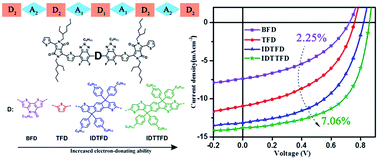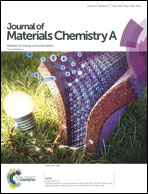Regulating the optoelectronic properties of small molecule donors with multiple alternative electron-donor and acceptor units for organic solar cells†
Abstract
A series of small molecules containing alternative multiple donor and acceptor units have been designed and synthesized. These small molecules introduce diketopyrrolopyrrole (DPP) and difluorobenzotriazole (DFBZ) as acceptor units and different donor cores with the intention to modulate intermolecular and intramolecular interactions and ultimately improve the power conversion efficiency (PCE). The structure–property relationship has been systematically investigated through exploring the effect of the electron-donating ability of the central donor unit on optoelectronic properties, crystallinity and morphology. As a result, IDTTFD has the strongest absorption in the visible region and appropriate energy levels. The organic solar cells based on IDTTFD/PC61BM achieve the highest PCE of 7.06% with a Voc of 0.86 V, a Jsc of 14.08 mA cm−2, and a FF of 58%.



 Please wait while we load your content...
Please wait while we load your content...